Tony Scott’s 2004 revenge drama starring Denzel Washington is Number 10 in my 30 day Film Notes series.
For newcomers, this month-long series of posts involves me watching a film every day for 30 days.
The following rules apply:
- It must be a film I have already seen.
- I must make notes whilst I’m watching it.
- Pauses are allowed but the viewing must all be one session.
- It can’t be a cinema release.
The point is to capture my instant thoughts about a movie and my overall film diet for 30 days, as well as post interesting links to the film in question.
Here are my notes on Man on Fire (2004) which I watched on BBC1 HD via PVR on Saturday 24th March.
- There is a weird Harry Potter connection to this film: JK Rowling’s agent Christopher Little also represents the A.J. Quinnell – author of the book on which it is based.
- It has been filmed once before in 1987, with Scott Glenn in the Creasy role.
- In that film the action was in Italy but here it has been relocated to Mexico.
- Chanting music over opening titles, interchanging film stocks and the AVIDs are working overtime!
- Walken and Washington have an instinctive rapport – we immediately get the vibe that these guys know each other
- Dialogue establishes that they have been involved in some heavy stuff (ex-special ops)
- Harry Gregson’s score has been used in a lot of news documentaries
- Note the sound on the lighting of Mickey Rourke’s match – Scott loves a visceral audio mix.
- The fleet of cars driving across the landscape recalls REVENGE (1990) another revenge themed film Scott shot in Mexico.
- Some stylistic similarities between the two films, even though Scott has utilised the advances in digital editing and post-production
- Neat trick making Dakota Fanning a precocious child – she’s essentially playing a version of herself.
- Radha Mitchell was coming of the success of PITCH BLACK (2000) – she looks beautiful but her role is rather underwritten
- First time I’ve seen this in HD and the clarity of image and golden hues are stunning (like his brother Ridley, Tony Scott is a master of light).
- Nice tension created about a possible kidnapping in the traffic through cutting and camera.
- Mitchell and Washington’s conversation is unusually constructed – use of zooms into the mirror used as well as conventional edits.
- The ‘Creasy getting drunk’ scene is a little overcooked.
- Like the fact that Walken has several phones – well researched detail.
- Pita at the pool sequence is a good example of Scott’s attention to sound.
- Pita: “Creasy, what’s a concubine?”
- Nice chemistry between Fanning and Washington
- Build up to the kidnapping is nice – interesting blend of camera moves, edits and sounds
- Note the calm of the classical piano
- Scott is using digital editing systems almost as a paintbox
- Old school editors must be turning in their grave at a film like this
- Like the fact that Spanish is spoken and the way the subtitles are done – slinking along the screen in sync with the words
- Bursts of Lisa Gerrard’s vocals are used in this film to indicate emotion – her extraordinary voice was first used in THE INSIDER (1999) and then GLADIATOR (2000)
- The visuals used to denote the kidnappers are insane
- Ransom demand scene is not quickly edited (although it feels like it) but the flashing and speeded up effects give that vibe.
- Like the way “La Hermandad” pops up in sync with dialogue.
- Reverse chopper shot of Mexico skyline used from earlier?
- Walken’s performance has a nice easy vibe that provides some welcome relief from the heavy drama.
- Rachel Ticotin previously filmed TOTAL RECALL (1990) in Mexico.
- Creasy quickly becomes a vengeful badass but that’s logical given his line of work.
- Finger cutting scene is intense but it’s the kind of sequence that would infuriate the late Pauline Kael and her many acolytes.
- Car falling off cliff recalls similar scene in THE LAST BOY SCOUT (1991).
- Creasy looks a bit out of place at the rave with that head scarf.
- I think Tony Scott should do a whole film set at a rave – really go to town.
- Split screen, bleach bypass, hand cranked cameras – this is visual overload!
- One way Scott and his DP Paul Calderon relieve the furious style is to cut to a relatively pristine image.
- The dancers cheering Creasy’s shotgun blasts is an effective touch – shows the atmosphere of mayhem.
- Great night time photography in the conversation between Washington and Ticotin
- Walken line about Creasy’s art is priceless – still not sure if it’s delivered with a metaphorical wink to the audience
- Would it really be practical to fire a rocket launcher into a busy Mexican high street?!
- Impressive explosion and flames however, plus this scene gave us the poster image.
- Great location for the ass bomb scene. Really notice the lighting in HD.
- It would have been really cool if the on screen stopwatch had synced in real time.
- Washington’s delivery of his lines in this scene is excellent.
- I bet someone somewhere has actually used the line “I wish. You had. More time!” just to be a badass.
- Tony Scott was clearly born to shoot in Mexico.
- Interior lighting of characters is tremendous.
- Radha Mitchell doesn’t seem that distressed her husband has just blown his head off in their home.
- It would be fair to say that this film is not a study of the social conditions that produce violence and kidnapping.
- Creasy refusing money and blowing the hand off the Voice’s brother shows he really doesn’t care about what drives the ransom business (i.e. money)
- Nice reverse offer from The Voice (“I will give you her life for your life”).
- Interesting choice of time and location for the climax (often films end
- Great shooting and use of music for the end.
- Film has a slightly different resonance after the Fritzl case and all the subsequent kidnap films which almost became a Euro subgenre.
- Like the way a mainstream film doesn’t wimp out at the end.
- Nice symbolic touch of him dropping the St Jude medallion at the end and the credit that gives the date of the final day (Dec 16th 2003)
- Alternate ending has Creasy going to the house of the Voice and blowing it all up.


